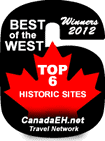Prince Albert National Park

Park Size: 3800 sq. km
Difficulty: Easy - Family
Park Amenities:
Prince Albert National Park
 Prince Albert National Park is a recreation and historical destination with a rich natural and cultural history and a variety of recreational opportunities available. The park is located one hour north of the community of Prince Albert, Saskatchewan, Canada. The park, first established in 1928, is a top destination in the province for relaxation, adventure and activity.
Prince Albert National Park is a recreation and historical destination with a rich natural and cultural history and a variety of recreational opportunities available. The park is located one hour north of the community of Prince Albert, Saskatchewan, Canada. The park, first established in 1928, is a top destination in the province for relaxation, adventure and activity.
Activities enjoyed in the Prince Albert National Park during the summer include camping, boating, biking, fishing, golfing, canoeing, birdwatching, tennis, water skiing, swimming, kayaking, sailing, wind surfing, hiking, picnicking, birdwatching, backpacking and wilderness camping. In the winter months cross country skiing, snowshoeing, wildlife viewing and ice fishing are enjoyed.

The Prince Albert National Park is the largest national park in Saskatchewan, Canada measuring over 3800 square kilometres. The vast landscape is located within a biological transition zone of boreal forest and aspen parkland surrounded by lakes, rivers and grasslands.
The national park protects the parkland environment, as well as, provides refuge for many species of wildlife. For example the park protects the Sturgeon River Plains Bison Herd, areas of intact plains rough fescue grasslands and the only fully protected a white pelican nesting colony in Canada. Not to mention there have been over 230+ bird species sighted in the park.
Other wildlife sightings in the park include moose, elk, black bear, gray wolf, pine marten, otter, beaver, lynx and coyote. Do not feed the wildlife and never approach wildlife for your own safety.
In the park is the Waskesiu Townsite on the shores of Waskesiu Lake providing services and supplies. There are accommodations, campgrounds, restaurants, coffee house, outfitters, gift shops, art galleries, liquor store, theatre, library, marina, gas station, ATM and a grocery store.
In the Waskesiu Townsite is the 17 kilometre long Red Deer Trail. The trail is divided into three sections - the blue loop, the yellow loop and the red loop trails. The trails all connect to form one large loop route ideal for exploring the village and the shores of Waskesiu Lake.
Throughout the park are campgrounds, recreation trails, canoe routes, wilderness campsites and day use picnic areas. The trails and waterways (ideal for canoeing) explore a series of lakes. The main lakes being the Waskesiu, Crean, Kingsmere, Namekus and Sandy Lakes.
The Waskesiu Lake is the best lake for motorized boats while some of the other smaller lakes are ideal for canoeing, kayaking and fishing. Fishing requires a Prince Albert National Park fishing license, which can be purchased at the Visitor Centre, entrance gates, campground kiosks and the three marinas. Most fish for walleye, trout, whitefish and northern pike.
On many of the lakes are picnic day use sites. The day use sites vary and, may or may not, include picnic tables, kitchen shelters, fire pits, playgrounds, boat launches, sandy beaches, pit toilets, swimming areas, washrooms, grass lawns, piers and docks.
It is on Ajawaan Lake where the Gray Owl Cabin. A historical site of the famed conservationist Grey Owl. Grey Owl was British but moved to Canada and adopted the First Nation way of living in the wilderness.
Grey Owl's cabin is known as "Beaver Lodge", visiting this historic building is the highlight of one of the more popular backpacking trails and canoe routes in the park.
Trails in the Prince Albert National Park range from easy day hikes to long haul backpacking adventures leading to wilderness campsites. Some trails are interpretive trails with information signs. Some are paved, some dirt and some boardwalk trails. Most include viewpoints and sitting benches.
Some of the other trails in the park popular for hiking, backpacking, sightseeing and/or biking include the Shady Lake (1.7 km), Spruce River Highlands (8.5 km), Elk (39 km one way), Amyot Lake (15.5 km), Treebeard (1.2 km), Waskesiu River (2.5 km), Narrows Peninsula (3 km), Grey Owl (20 km one way) and Fisher (7.2 km) Trails.
The longer trails in the Prince Albert National Park include backcountry campgrounds. They are remote campsites with minimal services like a tent pad, picnic tables, pit toilets, food caches and firewood.
All backcountry campers are required to register and obtain a backcountry camping permit at with the Visitor Centre before heading into the backcountry for the night.
Address:







